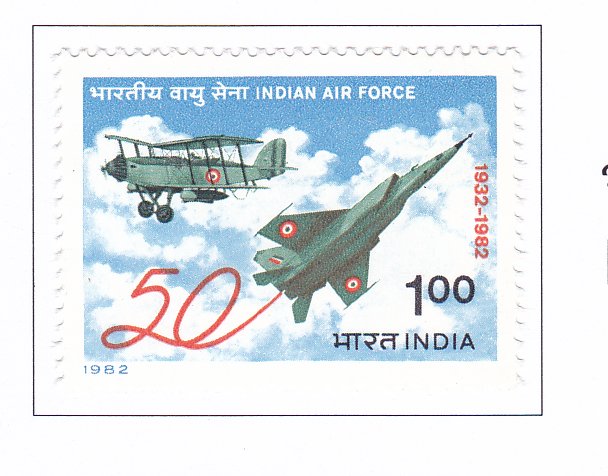50th Anniversary of Indian Air Force

Technical Data
| Date of Issue | October 8, 1982 |
|---|---|
| Denomination | Rs. 1 |
| Quantity | 2,000,000 |
| Perforation | comb 13¼ x 13 |
| Printer | Security Printing Press, Nashik |
| Watermark | No Watermark |
| Colors | Multicolor |
| Catalog Codes |
Michel IN 918 Stamp Number IN 989 Yvert et Tellier IN 729 Stanley Gibbons IN 1053 |
| Themes | Air Forces | Aircraft | Anniversaries and Jubilees | Aviation |
The Indian Air Force (IAF) has a rich history that dates back to the early dawn of India’s freedom struggle. The vision of an independent India with its own Air Force became a reality on October 8, 1932, with the Indian Air Force Act coming into effect and the commissioning of the first batch of Indian pilots at Cranwell in the United Kingdom.
On April 1, 1933, a nucleus of the Indian Air Force was formed at Drigh Road, Karachi, comprising six officers, twenty-two Hawai Sepoys, and four Westland Wapiti aircraft. Just four years later, this small force saw its first battle experience, operating from Miranshah in North Waziristan to subdue a rebellion.
During World War II, the IAF underwent rapid expansion, with its strength rising from six flights in 1939 to seven full squadrons in 1943 and ten squadrons in 1945. These squadrons, equipped with Hurricanes and Spitfires, saw action in Burma, gaining valuable battle experience.
The partition of India in 1947 left the country with only five and a half squadrons of fighter aircraft and one transport squadron. The IAF played a crucial role during this period, evacuating people across the new border and providing airlift support to the Indian Army during the Kashmir conflict.
In 1948, the IAF entered the jet age with the acquisition of Vampires, becoming the first Asian Air Force to do so. Over the years, the IAF has been involved in various operations, including providing aid during natural disasters like earthquakes and supporting the Indian Army during conflicts such as the Chinese aggression in 1962 and the Indo-Pak wars in 1965 and 1971.
Today, the IAF faces the future with confidence, sustained by the patriotism of the Indian people. It is increasingly self-reliant, with modern aircraft being built in Indian factories. The personnel of the IAF come from diverse backgrounds, united in their resolve to meet all challenges, whether in times of war or during natural calamities. They undergo rigorous training to ensure that they uphold the honor of the Indian skies.
The Indian Posts and Telegraphs Department commemorates the Golden Jubilee Celebration of the Indian Air Force with a special stamp, recognizing its significant contributions to the nation’s defense and security.
